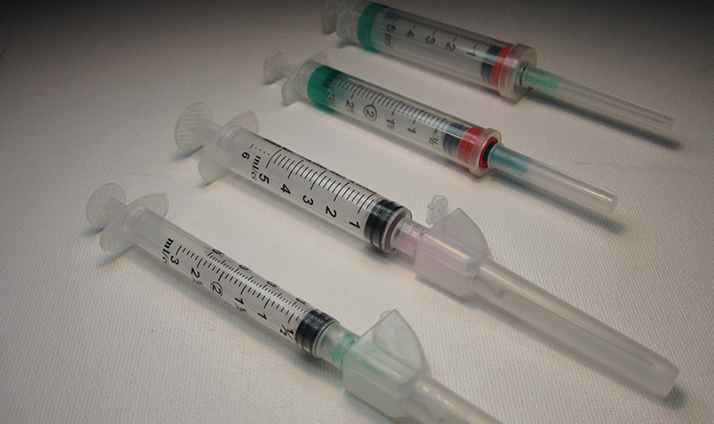What comes to mind when someone says needle stick injury? My first thought used to be HIV. Surprisingly, HIV transmission is actually much further down the list than you think, especially when you look at the blood-borne viruses that may be transmitted via needle stick injury (NSI).
Interesting facts on occupational NSIs:
- An estimated 1 million NSIs occur in Europe each year.1
- The most often executed procedures with injury risk are: intramuscular or subcutaneous injection (22%), taking blood samples, or during intravenous cannulation (20%), and repeatedly replacing the cap on an already used needle (30%). 3
- Even a minor sharp injury with only a small loss of blood carries the risk of transfer of over 20 pathogens, including Hepatitis B Virus (HBV), Hepatitis C Virus (HCV), HIV/AIDS virus, malaria, syphilis, tuberculosis, brucellosis, herpes virus and diphtheria. 3
- The World Health Organization (WHO) estimates that more than two million health care workers experience the stressful event of a percutaneous injury with a contaminated sharp object each year. These exposures result in about 16,000 infections with HCV, 66,000 with HBV and about 1,000 (200-5000) with HIV4, which lead to about 1,100 deaths or significant disability. 3
- There is approximately a 3% risk of transmission of HCV from a NSI in a health care setting.5
- The UK Department of Health estimates the risk for HIV transmission after percutaneous (inner organs) exposure to HIV-infected blood as 3 per 1000 injuries (0.3%), or of 1 per 1000 (0.1%) after muco-cutaneous (mucus membrane and skin) exposure.6
- There is no risk of HIV transmission where intact skin is exposed to HIV-infected blood. (6)
- The risk of HBV transmission is around 30%5,7. This is why it is important for healthcare workers to have up-to-date HBV vaccinations.
- At least 18,000 health care professionals in Australia suffer from a NSI every year8
NSIs do pose a serious risk of blood-borne infections such as HBV, HCV, and HIV1. Working in a pharmacy, we may be exposed to needles, syringes and other sharps through participation in vaccination services, offering in-store blood glucose or cholesterol testing and, of course, by taking in community generated sharps waste from customers. So, the question is, how do we minimise our risk of NSI in our occupational setting?
Part of the solution is simply the safe disposal of sharps. This means having suitable procedures and policies on how to handle and dispose of sharps waste. For example, stores that participate in the Pharmacy Needle and Syringe Program (PNSP) have access to (and must have) an appropriate sharps disposal procedure. Those stores also have access to information on what to do in the event of an NSI and also how to proceed if someone finds a loose sharp or single needle/syringe. Essentially it comes down to sound occupational health and safety strategies.
Keeping in mind that sharps include syringe needles, scalpels, broken glass and other objects contaminated with blood from a source patient2, here are some key points to remember if you are dealing with sharps waste in your store:
- All sharps must be housed in an appropriate rigid walled, puncture resistant container. This includes community generated waste from your customers as well as waste generated in-store from vaccination programs etc. By ensuring loose sharps are housed correctly, the risk of NSI to the contractors who service the sharps disposal bins is greatly minimised.
- If your store is part of the PNSP, remind your customers they can return their sharps waste to your store for safe disposal. It is also worthwhile telling customers that once they have filled their sharps disposal container with sharps waste, it CANNOT be put into their household recycling bin. Sadly this is happening is some areas and has resulted in some waste contractors receiving a NSI.
- Encourage customers to not overfill their sharps disposal containers, and the same goes for the pharmacy’s sharps disposal bin.
- Sharps disposal containers and sharps disposal bins are for SHARPS WASTE ONLY. Cardboard, plastic bags, plastic soft drink bottles, take-away containers and glass jars are not suitable for sharps disposal.
By following sound occupational, health and safety procedures, and being vigilant about the safe disposal of sharps waste the risk of NSI will be dramatically reduced for all involved in the process of dealing with and disposing of sharps waste.
If you’re concerned about the handling of sharps waste in your pharmacy, talk to your manager about introducing a policy and procedure.
Sources:
1Himmelreich, Dr Heiko, Prof. Holger F. Rabenau, Dr Matthias Rinderman, Dr Christoph Stephan, and Dr Markus Bickel, Prof. Ingo Marzi, Dr Sabine Wicker. “The management of needlestick injuries.” Dtsch Arztebl International 110.5 (2013): 61-67. 2Prüss-Üstün, A, E Rapiti, and Y Hutin. Sharps injuries: Assessing the burden of disease from sharps injuries to health-care workers at national and local levels. N.p.: World Health Organization, 2005. Print. 3Goniewicz, Mariusz, Anna Włoszczak-Szubzda, Marcin Niemcewicz, Magdalena Witt, and Anna Marciniak-Niemcewicz, Miroslaw Jerzy Jarosz. “Injuries caused by sharp instruments among healthcare workers–international and Polish perspectives.” Annals of Agricultural and Environmental Medicine 19.3 (2003): 523-27. Web. 15 May 2015. 4Prüss-Üstün, A, E Rapiti, and Y Hutin. Sharps injuries: global burden of disease from sharps injuries to health-care workers. N.p.: World Health Organization, 2003. Print. 5“Transmission.” Hepatitis Victoria, 2013. Web. <http://www.hepcvic.org.au/page/transmission> .6Department of Health. HIV post-exposure prophylaxis: Guidance from the UK Chief Medical Officers’ Expert Advisory Group on AIDS. London: n.p., 2008. N. pag. Print. 7Hepatitis Queeensland. The ABC of Hepatitis Training Package. Queensland: n.p., 2013. N. pag. Print. 8Murphy C. Improved surveillance and mandated use of sharps with engineered sharp injury protections: a national call to action. Healthcare Infection. 2008. 13:33-1107.
Alannah Priddle is a Professional Practice Pharmacist in the Queensland Branch of the Pharmacy Guild of Australia. She is the project manager for the Pharmacy Needle and Syringe Program.

